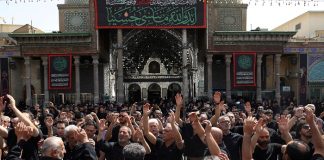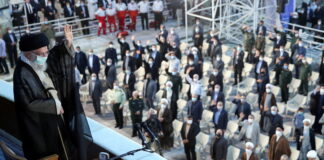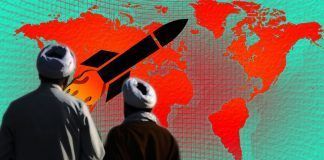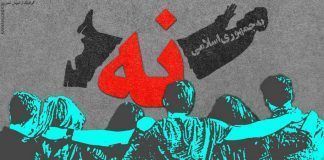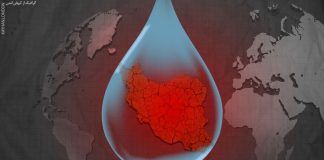The former commander of the Islamic Revolutionary Guards Corps’ Qods Force (IRGC-QF) Brigadier General Ghasem Soleimani was killed in a targeted U.S. drone attack on
Baghdad’s International Airport on January 3.
Many political observers believe that General Soleimani was the second most powerful man in Iran. There is plenty of evidence to support that he was the Supreme Leader Ayatollah Ali Khamenei’s right-hand man. Commander Soleimani always sat next to Ayatollah Khamenei during the state, military, and religious ceremonies.
[aesop_image img=”https://kayhanlife.com/wp-content/uploads/2020/01/2020-01-03T000000Z_833375851_MT1ABCPR714624003_RTRMADP_3_ABACA-PRESS-scaled.jpg” panorama=”off” credit=”FILE PHOTO: Undated photo of Iranian general Qassem Soleimani (right), the powerful head of Iran’s Quds Force, seen next to Iran Revolution Supreme Leader Ali Khamenei in Teheran, Iran. REUTERS./” align=”center” lightbox=”off” captionsrc=”custom” captionposition=”left” revealfx=”off” overlay_revealfx=”off”]
He received the highest military honor, the Order of Zolfaghar, in 2019. It was the first time the medal had been awarded to a military officer since 1979. Soleimani was posthumously promoted to the rank of Lieutenant General by Mr. Khamenei.
Mr. Khamenei led a large crowd of mourners, which included senior government and military officials, in prayers at Soleimani’s wake in Tehran. Footage broadcast on Iranian state TV showed a grief-stricken and tearful Khamenei delivering funeral prayers (Salat al-Janazah) over the coffins of Soleimani and others who died in the U.S. drone attack.
Soleimani’s death was a significant personal loss to Khamenei, who held the general in high esteem. It also delivered a massive blow to the Islamic Republic’s regional strategy and operations in Iraq, Syria, and Lebanon, which were led by the general.
Soleimani was arguably the most revered of all the regime’s senior officials. Many reformists and staunch critics of Khamenei and the establishment respected the general and held him in high regard.
Soleimani also formed close ties with several foreign leaders. They included Syrian President Bashar al-Assad, the Secretary-General of the Lebanese Hezbollah Hassan Nasrallah, the Secretary-General of Hamas’s political wing Ismail Haniyeh, and Abu Mahdi al-Muhandis, the Secretary-General of the Kata’ib Hezbollah — who died with Soleimani in the U.S. drone attack on Baghdad Airport.
Soleimani probably held more meetings with Russian President Vladimir Putin than any Iranian officials. His supporters hailed the general as the commander of the “Resistance Front” and “Islamic Iran.” His opponents regarded him as “the leading sponsor of terrorism in the world,” a “criminal” and a “monster.”
Although the U.S. had several opportunities reportedly to assassinate Soleimani in recent years, circumstances in Iran and the Middle East prompted Washington to follow through with the plan now. It is unclear to what extent the events in Iran played a part in the decision to kill him this time around. Also, how will Soleimani’s death change the regime’s political calculus?
General Soleimani and his supporters strongly opposed those factions inside the regime that advocated opening talks with the U.S., given that President Trump and his administration had outlined 12 conditions that Iran had to meet before any new negotiations could take place between the two countries. They demanded that Iran abandon its nuclear ambition, suspend its ballistic missile program and cease its regional military activities, which, if Iran were to comply with, would diminish the IRGC’s presence and influence in the region significantly.
While tensions between the U.S. and Iran reached boiling point after the assassination of Soleimani and the IRGC’s attack on the Al Asad Air Base, Washington and Tehran rushed to deescalate the situation by exchanging messages through diplomatic back channels involving the Swiss Embassy in Tehran, the Iraqi government and a few other intermediaries.
Meanwhile, the timing and circumstances of Soleimani’s death have prompted observers to speculate that Khamenei or people around him could have known about the plan to assassinate the general. Did the Islamic Republic intelligence agencies warn Soleimani about the impending threat during his last trip to Baghdad?
Also, we cannot dismiss personal motives in political power plays. It is not far-fetched to believe that Soleimani’s death would benefit a group, faction, or movement inside the regime. His increasing power and popularity could have posed a real threat to Khamenei and his supporters.
The charismatic commander of the Qods Force, who was well liked and highly respected by a vast segment of the public, could have further strengthened his position by bridging the gap between opposing political factions inside the regime.
In retaliation against Soleimani’s assassination, the Iranian military launched a series of missile attacks on the Al Asad Air Base in Iraq that housed the U.S. and Iraqi troops. The Iraqi government had received prior warnings from Tehran about the attack, giving the Iraqi and U.S. forces enough time to take shelter in bunkers.
Although no one was killed in the attack, the Pentagon later said 34 U.S. troops suffered traumatic brain injuries (TBI) caused by massive changes in atmospheric pressure that accompany an explosion such as one caused by a missile warhead.
Soleimani’s involvement in the affairs of the state extended beyond his military responsibilities in the region. Although the general preferred to keep a low profile and operate from the shadows, he was drawn into domestic factional infightings and political controversies.
In a letter dated March 17, 2018, former President Mahmoud Ahmadinejad (who was in office from 2005 to 2013) criticized Soleimani for not speaking out against the arrest of Hamid Baghaei in 2015, and again in 2017, on charges of embezzlement and misappropriation of public funds.
Mr. Baghaei, the former vice president in charge of executive affairs and a close ally of Mr. Ahmadinejad, was implicated in a corruption case involving the misappropriation of 3.76 million euros and $950,000 which were earmarked for the IRGC to spend in its African campaign.
[aesop_image img=”https://kayhanlife.com/wp-content/uploads/2020/01/احمدی-نژاد.jpg” panorama=”off” credit=”SOURCE: KAYHAN LONDON” align=”center” lightbox=”off” captionsrc=”custom” captionposition=”left” revealfx=”off” overlay_revealfx=”off”]
“You have fought against injustice in Syria and other places,” Ahmadinejad said in the letter. “The question remains, why have you not spoken out against the injustice committed in your name in our country? I may disclose information about our past dealings, which I mentioned in a letter I sent you on January 16 [2018].”
Soleimani, however, never interceded on behalf of Baghaei, who served time in prison.
By contrast, the general did not hesitate to intervene when Mehdi Jahangiri, the brother of current First Vice President Eshagh Jahangiri, was arrested and charged with embezzlement by the agents of IRGC’s Intelligence Protection Organization. The Judiciary reduced Jahangiri’s bail after Soleimani lobbied hard for his release.
“He was both my brother and a source of support,” Eshagh Jahangiri said after attending Soleimani’s funeral in Kerman, capital of the southeastern province of Kerman — the birthplace of both men.
There are many unconfirmed reports about Soleimani’s secret talks with U.S. officials.
According to Hossein Amir-Abdollahian, an aid to the Majlis (Iranian Parliament) Speaker Ali Larijani, General Soleimani spearheaded the trilateral talks between Iran, Iraq, and the U.S.
Mr. Amir-Abdollahian made the comments at a conference titled “Various Aspects and Consequences of Haj Ghasem Soleimani’s Assassination,” held at the School of International Relations in Tehran on January 19.
“General Soleimani was an exceptional military commander and a seasoned diplomat,” Amir-Abdollahian was quoted by the Islamic Republic News Agency (IRNA) as saying. “The leadership put him in charge of the talks during the trilateral meetings between Iraq, Iran, and the U.S. The general spent up to 100 hours chairing every meeting which sometimes lasted until two o’clock in the morning.”
In comments reported by the Sacred Defense news website (DEFA Press) on January 8, the deputy commander of the IRGC’s Sarallah Base in Tehran Brigadier General Mohammad Kowsari said: “The enemies had been keeping Ghasem Soleimani under surveillance for a long time. He had traveled to Syria and Lebanon before arriving in Iraq, where he was killed. We must find out who the infiltrators were.”
“Authorities had previously foiled three assassinations plots against the general inside Iran,” Gholamali Jaffarzadeh, a Majlis deputy representing Rasht, capital of the northern province of Gilan said in an interview with the Iranian Students News Agency (ISNA) on January 5. “The investigation into discovering the identity of infiltrators continues.”
The lead editorial of the January 19 issue of the Tehran-based hardline Kayhan newspaper titled “Soleimani’s School of Power and Diplomacy” by Mohammad Imani hailed the achievements of General Soleimani and warned about the “backstabbers inside Iran.”
Soleimani was a prominent figure in Iranian politics, who influenced the country’s macro policy. He was the architect of Iran’s regional foreign policy. When Foreign Minister Mohammad Javad Zarif resigned his post on February 26, 2019, seemingly for being excluded from the official talks with the visiting Syrian President Assad, it was Soleimani who intervened and persuaded Mr. Zarif to withdraw his resignation.
[aesop_image img=”https://kayhanlife.com/wp-content/uploads/2020/01/سلیمانی-4.jpg” panorama=”off” credit=”SOURCE: KAYHAN LONDON” align=”center” lightbox=”off” captionsrc=”custom” captionposition=”left” revealfx=”off” overlay_revealfx=”off”]
A week later, Khamenei awarded Soleimani the Order of Zolfaghar in a small ceremony attended by a select group of senior military officials. The leader praised the general for his distinguished military service to the country and prayed that “God may grant him the ultimate honor of martyrdom.”
While some senior Iranian officials believe the assassination of Soleimani was part of a broader U.S. plan to force Iran back to the negotiating table, others argue that Mr. Trump used the military action to boost his chances of winning the 2020 presidential elections.
The hardline Kayhan said on January 4: “From now on, any official who advocates resuming talks with the U.S. is insulting the memory of the martyrs Soleimani, hurting our national security and that of other countries in the region. They should be prosecuted and punished to the full extent of the law.”
Some elements within the regime might have tried to weaken Khamenei’s “Resistance Front” by eliminating Soleimani. They could have even played a role in hatching and carrying out the plot.
Those who thought getting rid of Soleimani would increase Iran’s chances of resuming talks with the U.S. could not have been more wrong because his death has only strengthened the Islamist extremists in the country. It also prompted Washington to sanction several IRGC senior officials. As a result, Iran and the U.S. will not sit at a negotiating table soon.
Speaking at a news conference in September 2019, Brian Hook, the U.S. Special Representative for Iran and Senior Policy Advisor to Secretary of State Mike Pompeo, said: “The U.S. State Department would offer a $15-million reward for information that helped block the IRGC and Qods Force’s business operations.”
“This is a part of the Rewards for Justice program for information leading to the disruption of IRGC operations,” M. Hook explained. “We have taken this step because the IRGC operates more like a terrorist organization than it does a government.”
The cash reward could have tempted some people close to Soleimani to pass on sensitive information about his movements to the Americans. Trump has repeatedly said that the U.S. intelligence agencies were confident that Soleimani was planning multiple attacks at American interests and embassies in the region.
In October 2019, the U.S. special forces killed Abu Bakr al-Baghdadi, the leader of the Daesh, Arabic acronym for the Islamic State of Iraq and the Levant (ISIS), in Syria. Soleimani’s killing could be part of a broader plan by the U.S. to eradicate terrorism in the Middle east.
“When you see the scope and reach of what the Islamic Republic of Iran regime has done. We cannot forget they tried to kill someone in the United States of America,” Secretary Pompeo said in an interview with Bloomberg News on January 22. “They have conducted assassination campaigns in Europe. This is a global phenomenon. When we say Iran is the leading destabilizing force in the Middle East and throughout the world is because of this terror activity that they have now spread as cancer all across the globe.”
In an interview with the London-based Arabic-language newspaper Asharq Al-Awsat on January 23, Brian Hook warned Soleimani’s replacement, Brigadier General Esmaeil Ghaani, that “If he follows a similar path of killing Americans, he will meet the same fate.”
In September 2015, the Saudi-based newspaper Okaz described Soleimani as “the head of a cobra.”
Will General Ghaani be able to command the Qods Force as effectively as his predecessor? Was General Soleimani as successful in achieving his goals as some people have claimed?
Israeli Air Force and American drones have been pounding the Iranian-backed Shia militias and Qods Force military bases in Syria and Iraq in the past two years. The attacks have diminished the military capability of the Qods Force in the region significantly.
[aesop_image img=”https://kayhanlife.com/wp-content/uploads/2020/01/2020-01-09T000000Z_1218818079_MT1ABCPR715274002_RTRMADP_3_ABACA-PRESS-scaled.jpg” panorama=”off” credit=”FILE PHOTO: Iran’s Supreme Leader Ayatollah Ali Khamenei shows him and the newly-appointed commander of the Quds Force of the Islamic Revolutionary Guard Corps Esmail Qaani (R) during a mourning ceremony in Tehran for slain top general Qasem Soleimani,Tehran, Iran on January 9, 2020. REUTERS./” align=”center” lightbox=”off” captionsrc=”custom” captionposition=”left” revealfx=”off” overlay_revealfx=”off”]
Israeli airstrikes routinely destroy large caches of weapons and military equipment as soon as they are offloaded from Iranian commercial planes that are used to transport them to Syria.
Protesters have stormed and set fire to the Iranian consulate generals in the Iraqi cities of Najaf (south-central) and Karbala (southwest) in recent months. There have been several violent demonstrations against the Iranian presence in Iraq. General Soleimani allegedly engineered the attacks by members of the Iraqi Shia militia group, the Kata’ib Hezbollah, on the American Embassy in Iraq in December.
“Israel will target the head of the Iranian snake and extract its fangs,” Israel Katz, the Israeli foreign minister, said in an interview with Ynet news website in August 2019. “Iran is the head of the snake, and Ghasem Soleimani, the commander of the IRGC-QF, is the snake’s fangs.”
Commander Ghaani has big shoes to fill. He, however, does not appear to have the same military and political clout to continue in the footsteps of his charismatic predecessor.
All indications are that he will not have an easy time to complete many of General Soleimani’s projects that were left unfinished after his death.
[Translated from Persian by Fardine Hamidi]


